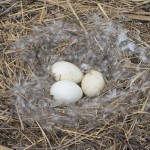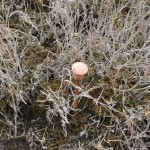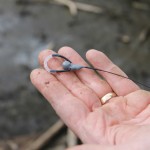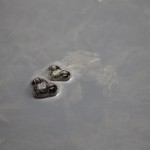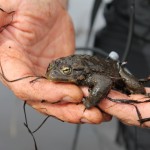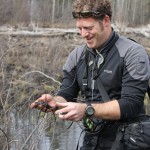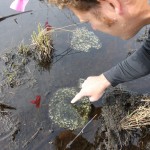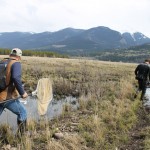By: Korie Marshall
Biologist Virgil Hawkes and his team want to know where toads, frogs and snakes living in Kinbasket’s drawdown zone spend their winters, and this summer they hope radio transmitters will help them figure it out.
Hawkes and Jesse Richter were in Valemount for a few days last week, studying the “Valemount Peatland.” The peatland is about 550 hectares along the West Canoe Forest Service Road, from the Canoe River to about 10.5 kilometers down the road. It is a flat area just below the full pool mark of the reservoir, and it is covered in marshes, ponds and fens when the reservoir is below full pool.
“These remnant fens don’t exist in this part of the province; this is unusual habitat,” says Hawkes. He is vice-president and senior biologist for LGL Limited Environmental Research Associates, a company that has been studying the drawdown zone for BC Hydro since about 2008.
One of the projects Hawkes is working on right now is looking at how amphibians and reptiles are using the drawdown zone – the area between the full pool and low pool marks in the reservoir. He says three amphibians and two reptiles should be using the drawdown area, because they are found outside of that area as well – Western toads, Columbia spotted frogs, long-toed salamanders, common garter snakes and Western terrestrial garter snakes. His team has found all but the Western terrestrial garter snake, and many signs that the peatland is a very productive habitat, despite being inundated yearly. But they haven’t yet figured out where many of the animals spend their winter.
The team has been catching frogs, toads, and other animals to measure them, noting which ponds they are finding eggs, tadpoles, juveniles and adults. So far they have mapped 48 ponds in the peatland, but there are more. Last week they started a bit of a pilot project to track individual animals, and hopefully see where they are going throughout the summer and into the fall and winter.
Last week, Hawkes and Richter fitted five Western toads with radio tracking devices, and in a few weeks they’ll be back to try to tag some garter snakes. Then over the summer, they will have teams coming periodically to find each animal using an antenna, and mark their locations with GPS. Hawkes says the toads can sometimes wiggle out of the tracking device, which only last about 5-6 months, but he is hopeful they’ll get some good data from here in the peatland, as well as from a few animals in the Wood Arm and Revelstoke Reach areas of Kinbasket.
The tracking devices will last a bit longer on the snakes, because they are bigger – the device is limited by the size of the battery, as you can only use a device that is less than one tenth the weight of the animal. Hawkes says Valemount is known for some of the largest garter snakes in the province. Kelly Boyle, a graduate student who was working here for two years with LGL studying the garter snakes, caught the largest one on record for the Kinbasket area – over a meter long.
“They are out there because there is a major food resource, toads and tadpoles,” says Hawkes. “That is pretty much all they are eating.”
Hawkes wants answers to some of the questions that have been nagging them about the behavior of the animals – “Where do they spend their time during the day? Do they move out of the drawdown zone when the reservoir comes up? Will they overwinter here? With the telemetry data we should be able to answer those questions quite definitively.”
Jen Walker-Larson, spokesperson for BC Hydro, says the reptile and amphibian monitoring program was recommended by the Columbia River Water Use Plan, which was approved in 2007. The plan calls for BC Hydro to implement a number of monitoring programs and physical works projects over 12 years on the Columbia River, from Kinbasket Reservoir to the US border. She says the objective of the reptile and amphibian monitoring program is to better understand their use of the drawdown zone and how they are affected by reservoir operations.
Other projects implemented in the Valemount area because of the Water Use Plan are the Valemount Marina boat ramp improvement, the ongoing debris management plans, re-vegetation planting and bird studies. Walker-Larsen says the projects are a significant investment by BC Hydro to benefit recreation, fisheries, vegetation, wildlife and archaeology values, and to better understand how reservoir operations affect other interests n the Columbia basin.
Hawkes says the debris program is also helping the wetlands, because the woody debris can clog up the marsh areas, especially in very high years like last year, making them less productive. He says the re-vegetation work in this end of Kinbasket wasn’t very effective, but the presence of the yellow water-lily, Nuphar polysepala, seen in “Pond 12” as it’s known by LGL staff, indicates a very stable marsh system. The Canada geese, whose nest we found on the edge of Pond 12, seem to agree.



